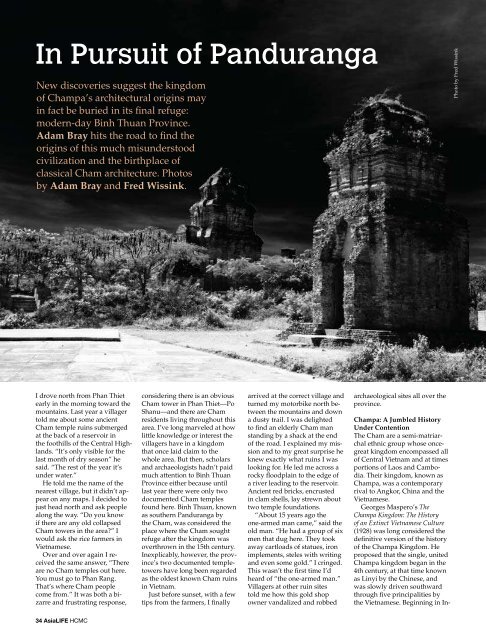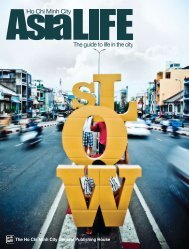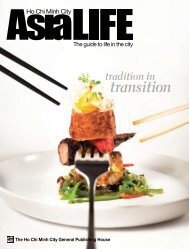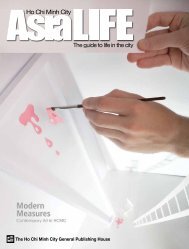Brett Davis - AsiaLIFE Magazine
Brett Davis - AsiaLIFE Magazine
Brett Davis - AsiaLIFE Magazine
You also want an ePaper? Increase the reach of your titles
YUMPU automatically turns print PDFs into web optimized ePapers that Google loves.
In Pursuit of Panduranga<br />
New discoveries suggest the kingdom<br />
of Champa’s architectural origins may<br />
in fact be buried in its final refuge:<br />
modern-day Binh Thuan Province.<br />
Adam Bray hits the road to find the<br />
origins of this much misunderstood<br />
civilization and the birthplace of<br />
classical Cham architecture. Photos<br />
by Adam Bray and Fred Wissink.<br />
Photo by Fred Wissink<br />
Looking up inside Thap Po Dam Tower<br />
New discoveries suggest not<br />
only that Panduranga may<br />
have developed independently<br />
during the earliest days of<br />
Champa, but that it may in fact<br />
be the earliest seed of Cham<br />
culture in Vietnam.<br />
I drove north from Phan Thiet<br />
early in the morning toward the<br />
mountains. Last year a villager<br />
told me about some ancient<br />
Cham temple ruins submerged<br />
at the back of a reservoir in<br />
the foothills of the Central Highlands.<br />
“It’s only visible for the<br />
last month of dry season” he<br />
said. “The rest of the year it’s<br />
under water.”<br />
He told me the name of the<br />
nearest village, but it didn’t appear<br />
on any maps. I decided to<br />
just head north and ask people<br />
along the way. “Do you know<br />
if there are any old collapsed<br />
Cham towers in the area?” I<br />
would ask the rice farmers in<br />
Vietnamese.<br />
Over and over again I received<br />
the same answer, “There<br />
are no Cham temples out here.<br />
You must go to Phan Rang.<br />
That’s where Cham people<br />
come from.” It was both a bizarre<br />
and frustrating response,<br />
considering there is an obvious<br />
Cham tower in Phan Thiet—Po<br />
Shanu—and there are Cham<br />
residents living throughout this<br />
area. I’ve long marveled at how<br />
little knowledge or interest the<br />
villagers have in a kingdom<br />
that once laid claim to the<br />
whole area. But then, scholars<br />
and archaeologists hadn’t paid<br />
much attention to Binh Thuan<br />
Province either because until<br />
last year there were only two<br />
documented Cham temples<br />
found here. Binh Thuan, known<br />
as southern Panduranga by<br />
the Cham, was considered the<br />
place where the Cham sought<br />
refuge after the kingdom was<br />
overthrown in the 15th century.<br />
Inexplicably, however, the province’s<br />
two documented templetowers<br />
have long been regarded<br />
as the oldest known Cham ruins<br />
in Vietnam.<br />
Just before sunset, with a few<br />
tips from the farmers, I finally<br />
arrived at the correct village and<br />
turned my motorbike north between<br />
the mountains and down<br />
a dusty trail. I was delighted<br />
to find an elderly Cham man<br />
standing by a shack at the end<br />
of the road. I explained my mission<br />
and to my great surprise he<br />
knew exactly what ruins I was<br />
looking for. He led me across a<br />
rocky floodplain to the edge of<br />
a river leading to the reservoir.<br />
Ancient red bricks, encrusted<br />
in clam shells, lay strewn about<br />
two temple foundations.<br />
“About 15 years ago the<br />
one-armed man came,” said the<br />
old man. “He had a group of six<br />
men that dug here. They took<br />
away cartloads of statues, iron<br />
implements, steles with writing<br />
and even some gold.” I cringed.<br />
This wasn’t the first time I’d<br />
heard of “the one-armed man.”<br />
Villagers at other ruin sites<br />
told me how this gold shop<br />
owner vandalized and robbed<br />
archaeological sites all over the<br />
province.<br />
Champa: A Jumbled History<br />
Under Contention<br />
The Cham are a semi-matriarchal<br />
ethnic group whose oncegreat<br />
kingdom encompassed all<br />
of Central Vietnam and at times<br />
portions of Laos and Cambodia.<br />
Their kingdom, known as<br />
Champa, was a contemporary<br />
rival to Angkor, China and the<br />
Vietnamese.<br />
Georges Maspero’s The<br />
Champa Kingdom: The History<br />
of an Extinct Vietnamese Culture<br />
(1928) was long considered the<br />
definitive version of the history<br />
of the Champa Kingdom. He<br />
proposed that the single, united<br />
Champa kingdom began in the<br />
4th century, at that time known<br />
as Linyi by the Chinese, and<br />
was slowly driven southward<br />
through five principalities by<br />
the Vietnamese. Beginning in Indrapura<br />
(near modern Danang),<br />
they retreated to Amaravati<br />
(Quang Nam Province), the<br />
Vijaya (26 km from Qui Nhon),<br />
then Kauthara (Nha Trang),<br />
finally seeking refuge in Panduranga<br />
(Binh Thuan and Ninh<br />
Thuan provinces).<br />
Within Maspero’s history is a<br />
poorly-explained account of the<br />
abandonment of Indrapura and<br />
the holy city of My Son during<br />
the 8th and 9th centuries and<br />
the subsequent relocation to<br />
Panduranga and Kauthara by<br />
Champa’s rulers. All of the earliest<br />
known Cham temples are<br />
located in Panduranga and date<br />
from this period. The surviving<br />
temples at My Son were all built<br />
after Maspero believed the capital<br />
shifted back to Indrapura,<br />
a century later. There are older<br />
rudiments attributed mostly to<br />
the Linyi period in My Son but<br />
they are not vestiges of classical<br />
Cham temple-towers.<br />
However, Michael Vickery’s<br />
2005 working paper “Champa<br />
Revised” throws that all out<br />
the window. Vickery asserts<br />
that Champa was a loosely affiliated<br />
group of perhaps three<br />
autonomous principalities,<br />
each developing independently<br />
and in parallel, with their own<br />
respective ruling elite. Vickery<br />
argues that Maspero’s assertion<br />
that Champa evolved from<br />
Linyi is pure “historical fiction”<br />
and points out that much of his<br />
history is based on unfounded<br />
assumption, misunderstandings,<br />
myth and all-too heavy<br />
reliance on skewed ancient Chi-<br />
Thap Po Dam Tower<br />
nese and Vietnamese histories.<br />
He seems to imply a much later<br />
emergence of Cham—perhaps<br />
in the 7th or 8th century. Vickery<br />
maintains that the shifting<br />
pre-eminence (and subsequent<br />
decline a century later) of Panduranga<br />
in the 8th century (and<br />
again in the 11th century) is due<br />
to changes in trade routes and<br />
not migrations of royal families<br />
and capital cities.<br />
I agree with Vickery. Newlydiscovered<br />
temple ruins here in<br />
Binh Thuan Province suggest a<br />
continual prominence of Panduranga<br />
as an active religious<br />
realm from the earliest days of<br />
Champa. I’ve located clusters<br />
of temple ruins in the north of<br />
the province, which point to the<br />
possibility of a holy city. Likewise,<br />
the little-known ancient<br />
Cham citadel wall surrounding<br />
the town of Song Luy in central<br />
Binh Thuan is incontrovertible<br />
evidence of an impressive<br />
military or royal presence in<br />
Panduranga.<br />
Even more exciting however,<br />
are the recently disclosed<br />
discoveries of more than a<br />
dozen Sa Huynh sites by the<br />
government. The Sa Huynh<br />
culture (known chiefly for its<br />
use of burial-cremation jars and<br />
intricate jewellery) is one of<br />
the earliest known civilizations<br />
in Vietnam, dating back up to<br />
3,000 years. It’s largely believed<br />
that the Sa Huynh are ancestors<br />
of the Cham.<br />
All of these exciting new<br />
discoveries suggest not only<br />
that Panduranga may have<br />
developed independently dur-<br />
34 asialife HCMC asialife HCMC 35















